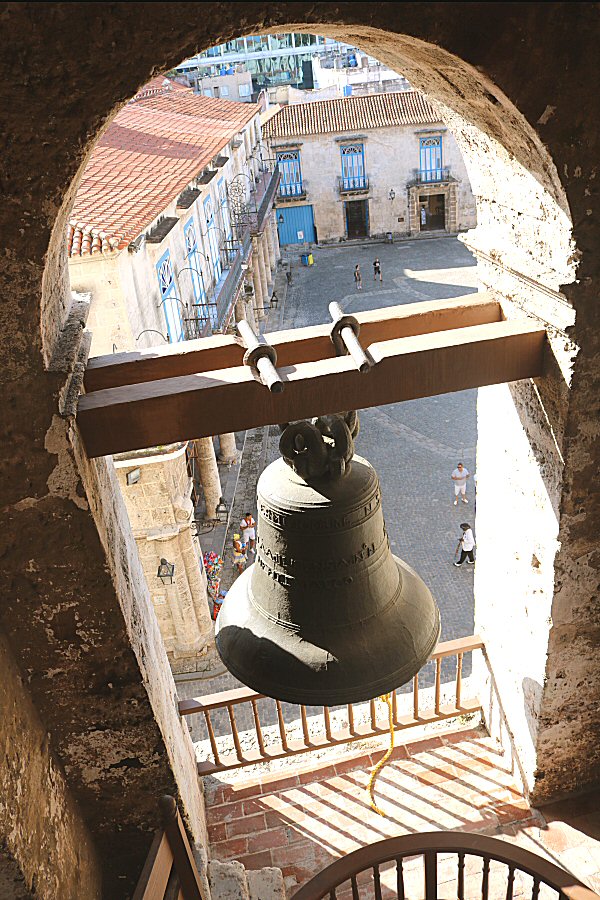
The Catedral de San Cristóbal de La
Habana is located on the Empedrado street #156, where it
intersects with the San Ignacio street, occupying the north part
of the Plaza de la Catedral.
The Catedral de San Cristóbal de la
Habana, dedicated
to the Virgin Mary, is one of the eleven cathedrals in Cuba. It
serves as the seat of the Roman Catholic Archdiocese of San
Cristobal de la Habana that includes Havana, Pinar del Rio and
Matanzas provinces. Catholicism is the largest organized
religion in the island, followed by other beliefs, such as Santería, Protestantism and
Budaism.
In 16th century Philip II, the King of Spain, decided to send missionaries to Florida that would catechize the Indians there. Father Pedro Martinez, another father, and a brother were charged with this task. The captain of the Belgian ship that these three embarked, did not know the route to San Agustin de Florida, so that he touched first at Havana to get information about the course. Thus, the Jesuits set the first step on the soil of Americas in 1566.
At
that time Havana had about 300 inhabitants, consisting mainly of
the native Indians. During their stay in Havana, these three
Jesuits made effort to instruct the habaneros in Christianity. A
few months later they sailed to their original destination.
However,
when Father Martinez landed with a group of sailors, as soon as
they saw the coasts of Florida, he was killed by the native
Indians on the strand, so that Father Pedro Martinez became the
first martyr of the order in Americas. Thereupon the ship
returned with the two Jesuits to Havana. With others coming from
Spain, they built a wooden church at the intersection of the Aguiar and the Empedrado streets in 1603, where today the Parque
de Cervantes is located, and started to preach to the natives
about the gospel.
In the 17th century the priests
of the Society of Jesus (the Jesuits) became the largest
missionary group in Havana. As more and more of the native
Indians were converted to Catholicism, the need for churches
grew parallel with this increase. The Jesuits requested many
times to construct a new church. Moreover, at the initiative of
the Bishop Diego Evelino Hurtado de Compostela they had
purchased a lot in the Plazuela de la Ciénaga (current Plaza de
la Catedral) to build a new church in 1700. The plaza was
located on the site of a former swamp that was drained and used
as a naval dockyard. There was a small humble hermitage,
made by guano and palm leaves and dedicated to San Ignacio de
Loyola, on the plot where the Jesuits was willing to build their
church. However, all their requests were denied by the Attorney
General Luis Gonzalo de Carvajal that was against any new
construction in this area, as he was considering this
restriction necessary for the protection of the city. Finally,
the Jesuits obtained the necessary permission by a Royal Decree
in 1721, and in 1727 they were notified
that they could build their church in the purchased plot in the
Plazuela de la Ciénaga (Swamp Square). According to
the plan, the church would be built as
the oratory of the Order of San Ignacio (St. Ignatius of Antioch)
that later would become a cathedral. The construction of the
cathedral began in 1748.
The Jesuits were highly credited by
their discipline in following the precepts of the Catholic
religion, so that the children of the wealthy Creoles residing
in Havana, were receiving their education from the Jesuits. The
College of San José, in that the Jesuits held office, was the
preferred institution. However, the rise of the Jesuits in the
society was interrupted in 1767, when the Spanish King Carlos
III decided to expel them from Spain and the overseas
territories. Consequently, their property in Cuba was
confiscated by the colonial government. Even though the Jesuits
were expelled from the island, the work had to continue, as
Havana needed its church. Bishop Gerónimo Valdés persuaded the
Spanish King to use the church of the Jesuits that was not
completed, as the main parish church, the Parroquial Mayor, was
completely in ruins. Thus, it was decided that the Franciscan
friars would complete the Jesuit church.
In 1777, the demolished church, the Parroquial Mayor, was moved to the almost completed building of
the Oratorio de San Ignacio. In 1778, by
order of Bishop Felipe
José de Tres Palacios, the process of
transforming the Oratory of San Ignacio into the Havana
Cathedral, dedicated to the Immaculate Conception whose image
can be seen above the altar, began, and in 1782,
the church was consecrated as the Cathedral of Havana. When the
building was completed in 1787, the diocese with the title of
San Cristóbal de La Habana was created, as a part of the primate
diocese of Santiago de Cuba, and the church was elevated to the
rank of a cathedral, which was officially confirmed in 1793.
Thereafter the country was divided into three dioceses: Havana,
Camagüey, and Santiago de Cuba. José Felipe Tres Palacios became
the first bishop of the diocese of the San Cristóbal de La
Habana.
When the French gained control over the
Hispaniola in 1795, the remains of Christopher Columbus were
moved from Santo Domingo, where they rested as the Genovese
sailor wished so, to the Havana Cathedral.
The ashes of the admiral were preserved in a
funerary monument in the central nave until 1898, when the
Spanish rule ended in Cuba, so that the remains of
the great explorer were returned to the Cathedral of Seville in
Spain.
The cathedral was renovated between 1946
and 1949 by the Cuban architect Cristóbal Martinez. Through
complex architectural procedures the interior of the cathedral
became more spacious and more luster, and the ventilation system
was improved. It was one of the first buildings to be restored
after the revolution in 1959. In 1982 it was designated a World
Heritage Site by UNESCO.


